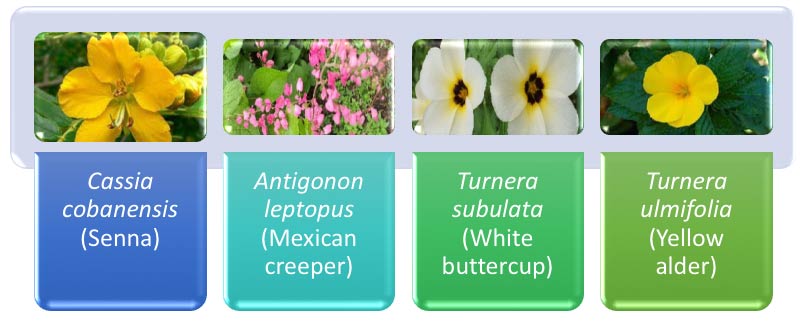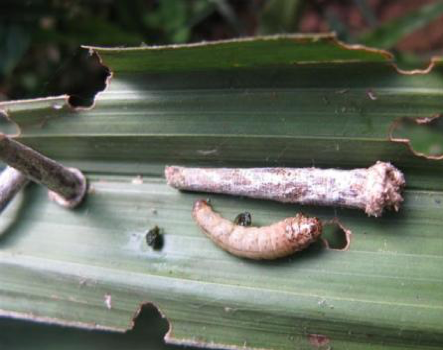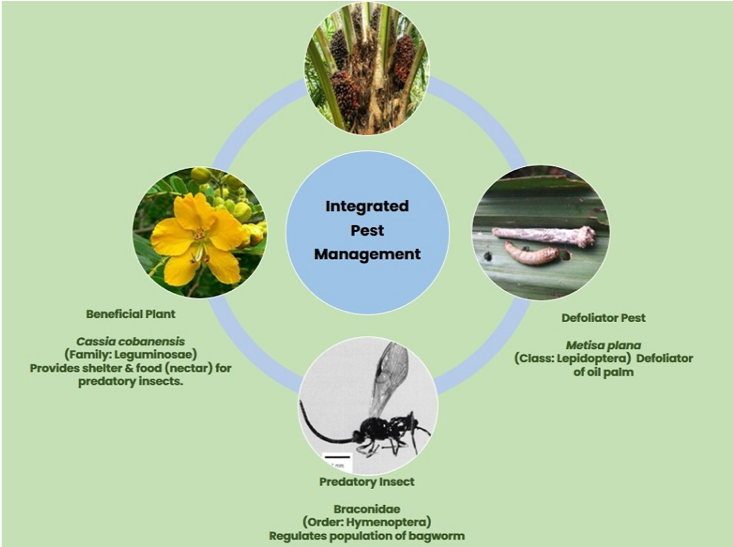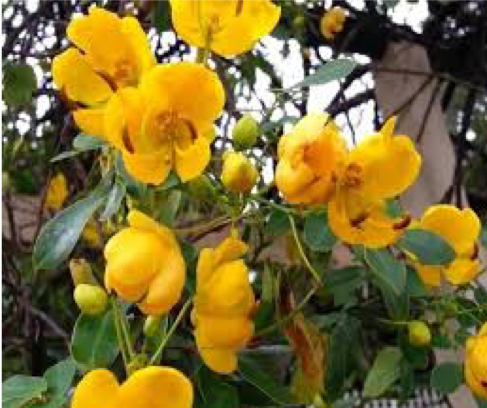Flowering plants are commonly planted around plantations in Malaysia. They are not only planted for the aesthetic value but more importantly for their benefit in Integrated Pest Management system practised in oil palm plantations. There are 4 types of common beneficial plants planted; Cassia cobanensis (Senna), Antigonon leptopus (Mexican creeper), Turnera subulata (White buttercup) and Turnera ulmifolia (Yellow alder). Among these, Cassia cobanensis is widely regarded as a superior choice.

 Cassia cobanensis (Britton) is the most common beneficial plant in plantations. It is widely planted along the roads of an oil palm plantation or in an open space or gaps. Since it is a non-shade tolerant plant, it is best grown in areas with sufficient sunlight. Cassia also known as Senna is one of the largest genus of flowering plants from the legume family of Leguminosae / Fabaceae). They grow diversely from the tropics to the temperate region. There are an estimated 260 – 350 species with 50 species known to be in cultivation.
Cassia cobanensis (Britton) is the most common beneficial plant in plantations. It is widely planted along the roads of an oil palm plantation or in an open space or gaps. Since it is a non-shade tolerant plant, it is best grown in areas with sufficient sunlight. Cassia also known as Senna is one of the largest genus of flowering plants from the legume family of Leguminosae / Fabaceae). They grow diversely from the tropics to the temperate region. There are an estimated 260 – 350 species with 50 species known to be in cultivation.
| Classification | |
|---|---|
| Kingdom: | Plantae |
| Phylum: | Tracheophyta |
| Class: | Magnaliopsida |
| Order: | Fabales |
| Family: | Leguminosae (Fabaceae) |
| Subfamily: | Caesalpinioideae |
| Genus: | Cassia (Senna) |
| Species: | cobanensis |
Botany of Cassia
It is a shrub which grows up to 1 meter in height with oblong elliptic shaped compound leaves and has fine hairs over the surface. The leaf axils (base of the leaf) has glands which exudates nectar which is favoured by insects. It bears yellow-orange composite flowers and upon maturity bears legume pods containing to several seeds.
Cultivation of Cassia
It is planted using seeds or vegetative propagation (using cuttings) and grows vigorously in open space with sufficient sunlight and rainfall. It requires minimal maintenance except during earlier stage of cultivation. This is also the reason why it is much preferred compared to the other beneficial plants. It is usually planted along roadside and drains in oil palm plantations around Malaysia or in open space or gaps within the plantation canopy.
Integrated Pest Management (IPM) is the use of holistic and compatible methods of pest and disease control to reduce crop damage and increase productivity. It uses the most cost-effective methods with minimum hazard and reduced overdependence on pesticides, thus making the management of plantations more sustainable. IPM is adopted in plantation by using biological control agents to control pest infestations and to increase yield productivity in a sustainable manner. This is where beneficial plants play an important role in pest management in oil palm plantations ensures best management of a plantation using eco-friendly and sustainable methods
Leaf-eating pests in oil palm plantations

Bagworm (Metisa plana) infesting on oil palm
Source: Pestnet.org
Bagworms, Metisa plana (Lepidoptera: Psychidae) and Pteroma pendula are some of the most destructive pests in an oil palm plantation. Bagworm infestation may cause serious crop loss due to defoliation and vigorously affects growth. It can reduce the overall yield of palm by up to 40% and requires at least 2 years to recover. Use of pesticides through trunk and spot or aerial spray in plantations were proven to be effective. However this method is not sustainable in the long run and are only practised during mass infestation.
Role of parasitoids in bagworm control

Parasitoids plays an important role in bagworm control Source: ScienceDirect.com
Parasitoids are small wasp-like insects which plays an important role in regulating and keeping control of bagworm population in oil palm plantation. The abundance and survival of parasitoids depends on the availability of shelter and food source. This is well provided by beneficial plants which provides shelter through the bushy canopy of the shrubs and nectar from the plant stipules which is a preferred food source. Braconids (Braconidae) parasitoid from the Order Hymenoptera are most abundant in oil palm plantations and are effective in regulating the population of defoliator bagworms. The parasitoid injects eggs into the host larvae (bagworm) via its ‘ovipositor’.
Braconidae parasitoids from the Order Hymenoptera are most abundant in oil palm plantations & are effective in regulating bagworm population
The eggs develops and later hatches inside the host cavity, where the nymph digests the host from within and emerges as imago. This is the parasitic cycle which regulates the bagworm population in a plantation.
Effectiveness of Cassia cobanensis in bagworm control in oil palm plantation

Cassia cobanensis has favourable nectar properties, easily available nectar and effective parasitism impact in oil palm plantations.
A field study, has proved that C. cobanensis are more superior and attracts most parasitoid species associated with the bagworm, compared to other plants mentioned above. It attracted more than 300 bagworm parasitoids compared to less than 10 for E. heterophylla, C. usaramoensis and A. intrusa (Basri et al., 2001). It also has a vigorous establishment compared to other plants and need less maintenance which makes it suitable for the establishment of natural predators, especially parasitoids.
 According to a study by Basri et al., (2001), C. cobanensis was able to support parasitoids for a longer period than any other beneficial plants and was proven to suppress the M. plana population, even after 30 months of planting. It was also a total of more than 300 bagworm parasitoids compared to less than 10 for E. heterophylla, C. usaramoensis and A. intrusa (Basri et al., 2001). The species of bagworm parasitoids which normally visit C. cobanensis are Brachymeria lugubris, Dolichogenidea metesae, Eurytoma sp., B. lasus, B. carinata, Goryphus bunoh, Elasmus sp., Paraphylax varius, Pediobius imbreus and P. anomalus.
According to a study by Basri et al., (2001), C. cobanensis was able to support parasitoids for a longer period than any other beneficial plants and was proven to suppress the M. plana population, even after 30 months of planting. It was also a total of more than 300 bagworm parasitoids compared to less than 10 for E. heterophylla, C. usaramoensis and A. intrusa (Basri et al., 2001). The species of bagworm parasitoids which normally visit C. cobanensis are Brachymeria lugubris, Dolichogenidea metesae, Eurytoma sp., B. lasus, B. carinata, Goryphus bunoh, Elasmus sp., Paraphylax varius, Pediobius imbreus and P. anomalus.

C. cobanensis to be much more superior and had attracted most parasitoid species associated with the bagworm, compared to the other plants mentioned above (Basri et al., 2001).
Most likely this is attributed to the nectar which was produced by the stipules under the leaf axils, which renders an easy access to the parasitoids and the high amount of sucrose in the nectar favoured by the parasitoids, thus it has high importance in creating a suitable habitat.
Biological protection in oil palm plantations includes strategies and management practices in using biological control components against pests, especially defoliators. These include the sustenance of the natural predatory insect populations by establishing beneficial plants which play as hosts. These host or beneficial plants not only attract predatory insects which are essential in pest management but also attract pollinators such as bees, butterflies and others. Beneficial plants such as Cassia cobanensis are proven to be superior and effective in managing pests in oil palm plantations. Use of such biological relations ensures good management of plantations with low dependency on synthetic pesticides and reduced cost on pest management while maintaining high yield of sustainable oil palm productions in the long term.
Reference;
- Basri, M W: Norman, K & Othman, A (2001). Field impact of beneficial plants on the parasitism levels of the bagworm, Metisa plana (Lepidoptera: Psychidae). Paper presented at PIPOC 2001.
- http://palmoilis.mpob.gov.my/publications/TOT/tt132.pdf
- https://akvopedia.org/wiki/Sustainable_Oil_Palm_Farming_/_Leaf-eating_insects
- http://www.rspo.org/sites/default/files/5-%20BMP%20for%20Oil%20Palm%20Cultivation%20on%20Peat%20Soils%20-%20Integrated%20Pest%20(Mukesh).pdf
- https://serv.biokic.asu.edu/neotrop/plantae/collections/individual/index.php?occid=3051292
- https://www.sciencedirect.com/science/article/abs/pii/S1226861518303583
Prepared by Mr. Anthony

